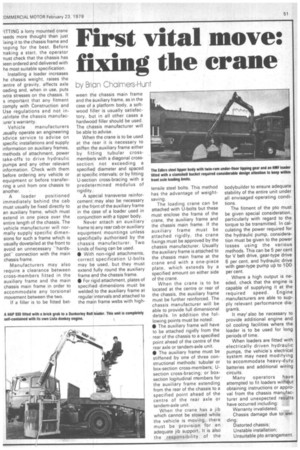First vital move: fixing the crane
Page 53

If you've noticed an error in this article please click here to report it so we can fix it.
by Brian Chalmers-Hunt
:ITT1NG a lorry mounted crane leeds more thought than just ixing it to the chassis frame and loping for the best. Before flaking a start, the operator nust check that the chassis has )een ordered and delivered with he most suitable specification.
Installing a loader increases he chassis weight, raises the :entre of gravity, affects axle oading and, when in use, puts )xtra stresses on the chassis. It s important that any fitment comply with Construction and Use regulations and not inialidate the chassis manufac.urer's warranty.
Vehicle manufacturers Jsually operate an engineering 3dvice service to advise on specific installations and supply information on auxiliary frames, methods of attachment, power take-offs to drive hydraulic pumps and any other relevant information. Check with them before ordering any vehicle or equipment or before transferring a unit from one chassis to another.
A loader positioned immediately behind the cab must usually be fixed directly to an auxiliary frame, which must extend in one piece over the entire length of the chassis. The vehicle manufacturer will normally supply specific dimensions for such a frame which is usually dovetailed at the front to avoid an unnecessary ''hardspotconnection with the main chassis frame.
Manufacturers may also require a clearance between cross-members fitted in the auxiliary frame and the main chassis main frame in order to accommodate any torsional movement between the two.
If a filler is to be fitted bet ween the chassis main frame and the auxiliary frame, as in the case of a platform body, a softwood filler is usually satisfactory, but in all other cases a hardwood filler should be used. The chassis manufacturer will be able to advise.
When the crane is to be used at the rear it is necessary to stiffen the auxiliary frame either by fitting tubular crossmembers with a diagonal crosssection not exceeding a specified diameter and spaced at specific intervals; or by fitting U-section cross-bracing with a predetermined modulus of rigidity.
A special transverse reinforcement may also be necessary at the front of the auxiliary frame in the case of a loader used in conjunction with a tipper body.
Never attach an auxiliary frame to any rear cab or auxiliary equipment mountings unless specifically authorised by the chassis manufacturer. Two kinds of fixing can be used.
• With non-rigid attachments, correct specification U-bolts may be used, but they must extend fully round the auxiliary frame and the chassis frame.
• For rigid attachment, plates of specified dimensions must be welded to the auxiliary frame at regular intervals and attached to the main frame webs with high tensile steel bolts. This method has the advantage of weightsaving.
The loading crane can be attached with U-bolts but these must enclose the frame of the crane, the auxiliary frame and the chassis main frame. If the auxiliary frame must be attached rigidly, the crane fixings must be approved by the chassis manufacturer. Usually the auxiliary frame is attached to the chassis main frame at the crane end with a one-piece plate, which extends by a specified amount on either side of the crane.
When the crane is to be located at the centre or rear of the chassis, the auxiliary frame must be further reinforced. The chassis manufacturer will be able to provide full dimensional details. In addition the following points must be noted: • The auxiliary frame will have to be attached rigidly from the rear of the chassis to a specified point ahead of the centre of the rear axle or tandem-axle unit.
• The auxiliary frame must be stiffened by one of three constructional methods: tubular or box-section cross-members; Usection cross-bracing; or boxsection logitudinal members for the auxiliary frame extending from the rear of the chassis to a specified point ahead of the centre of the rear axle or tandem-axle unit.
When the crane has a jib which cannot be stowed while the vehicle is moving, there must be provision for an adequate jib support. It is also the responsibility of the bodybuilder to ensure adequate stability of the entire unit under all envisaged operating conditions.
The fitment of the plc) must be given special consideration, particularly with regard to the torque to be transmitted. In calculating the power required for the hydraulic pump, consideration must be given to the power losses using the various methods. This can be 5 per cent for V belt drive, gear-type drive 6 per cent, and hydraulic drive with gear-type pump up to 100 per cent.
Where a high output is needed, check that the engine is capable of supplying it at the required speed. Engine manufacturers are able to supply relevant performance diagrams.
It may' also be necessary to provide additional engine and oil cooling facilities where the loader is to be used for long periods of time.
When loaders are fitted with electrically driven hydraulic pumps, the vehicle's electrical system may need modifying to accommodate heavy-duty. batteries and additional wiring circuits.
Many operators have attempted to fit loaders without obtaining instructions or approval from the chassis manufacturer and unexpected results have occurred including: Warranty invalidated; Chassis damage due to welding; Distorted chassis; Unstable installation: Unsuitable pto arrangement.




























































































































